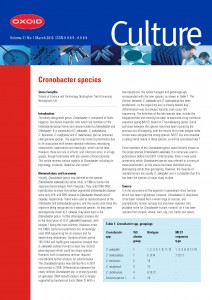Oxoid Culture Journal Focuses on Cronobacter Species and Mycobacterium bovis
- Like
- Digg
- Del
- Tumblr
- VKontakte
- Buffer
- Love This
- Odnoklassniki
- Meneame
- Blogger
- Amazon
- Yahoo Mail
- Gmail
- AOL
- Newsvine
- HackerNews
- Evernote
- MySpace
- Mail.ru
- Viadeo
- Line
- Comments
- Yummly
- SMS
- Viber
- Telegram
- Subscribe
- Skype
- Facebook Messenger
- Kakao
- LiveJournal
- Yammer
- Edgar
- Fintel
- Mix
- Instapaper
- Copy Link
Posted: 11 May 2010 | Thermo Fisher Scientific Inc. | No comments yet
Oxoid, a world leading microbiology brand, announced that the latest edition of its journal, Culture (Volume 31, No 1), is now available.
Oxoid, a world leading microbiology brand, announced that the latest edition of its journal, Culture (Volume 31, No 1), is now available.
Oxoid, a world leading microbiology brand, announced that the latest edition of its journal, Culture (Volume 31, No 1), is now available. The issue focuses on two key areas: the newly designated genus Cronobacter, an organism that has come to prominence due to its association with severe neonatal infections, necrotizing enterocolitis, septicaemia and potentially fatal meningitis, and Mycobacterium bovis, the causative bacterium of bovine tuberculosis.


The latest issue of Culture focuses on two key areas: the newly designated genus Cronobacter, and Mycobacterium bovis, the causative bacterium of bovine tuberculosis.
Authored by Dr. Steve Forsythe of the School of Science and Technology, Nottingham Trent University Nottingham, UK, the Cronobacter article reviews the physiology, virulence, detection and control of this newly designated genus. Cronobacter has been isolated from a range of foods, including cheese, meats, milk powder, powdered infant formula, cereals, wheat, corn, soy, rice, herbs and spices, vegetables, salads and a large number of food ingredients. The incidence of the bacterium in powdered infant formula has been well reported in neonates, particularly those with low birth-weights. With high mortality rates, this is the major group at risk.
In the U.S., the reported Cronobacter infection incidence rate is ~1 per 100,000 infants. This incidence rate increases to 9.4 per 100,000 in infants of very low birth weight, i.e. <1.5kg. The first neonatal deaths attributed to Cronobacter were in 1958. Since then, according to the FAO/WHO, around the world there have been 120 documented cases of neonatal and infant Cronobacter infections and at least 27 deaths.
Elsewhere in the new issue, Jessica Parry of the Veterinary Laboratories Agency, Weybridge, UK, describes how bovine tuberculosis (bTB) remains one of the most difficult animal health problems facing the farming industry in Great Britain today. Her article cites the 5,000 new incidents (breakdowns) of bTB in British herds in 2008, an increase of 19.6 percent over those recorded in 2007, and reports that post-mortem or culture evidence of M. bovis infection was detected in about 55 percent of these incidents, the so-called “confirmed” breakdowns. With over 40,000 animals slaughtered under the control programme in 2008, the article describes the control of bTB in cattle; laboratory testing for M. bovis including bacterial culture, microscopic examination and molecular typing; and describes the problem of bTB in Eurasian badgers (considered to be the most important host in wildlife and a significant vector of M. bovis infection for cattle in the United Kingdom (UK) and Ireland). The article concludes by looking at the future of bTB and 2010 eradication programmes in the UK.
For your copy of this informative journal, please speak to your local Oxoid representative, or email [email protected] or visit www.oxoid.com where this, and past issues of Culture, can be viewed and downloaded.
Oxoid is part of Thermo Fisher Scientific Inc., the world leader in serving science.



